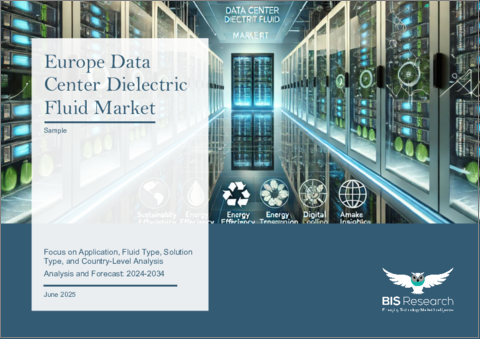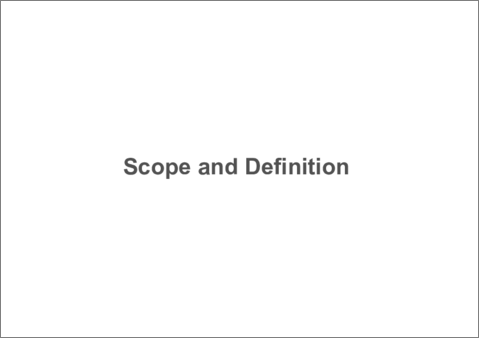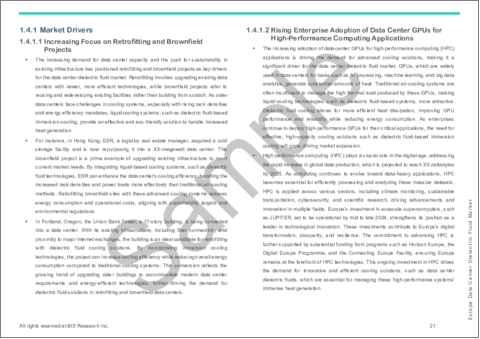|
|
市場調査レポート
商品コード
1756527
欧州のデータセンター用誘電流体市場:用途別、流体タイプ別、ソリューションタイプ別、国別 - 分析と予測(2024年~2034年)Europe Data Center Dielectric Fluid Market: Focus on Application, Fluid Type, Solution Type, and Country-Level Analysis - Analysis and Forecast, 2024-2034 |
||||||
カスタマイズ可能
|
|||||||
| 欧州のデータセンター用誘電流体市場:用途別、流体タイプ別、ソリューションタイプ別、国別 - 分析と予測(2024年~2034年) |
|
出版日: 2025年06月26日
発行: BIS Research
ページ情報: 英文 81 Pages
納期: 1~5営業日
|
全表示
- 概要
- 図表
- 目次
欧州のデータセンター用誘電流体の市場規模(英国を除く)は、2024年に3,799万米ドルとなりました。
同市場は、29.63%のCAGRで拡大し、2034年には5億920万米ドルに達すると予測されています。欧州におけるデータセンター冷却事業の拡大を支えているのは、カーボンフットプリントに対する関心の高まりと、持続可能でエネルギー効率の高い熱管理の必要性です。システム性能と誘電流体化学の進歩により、採用が加速しています。同時に、RoHS、REACH、F-Gasなど、業界の協力的な活動やEUの厳しい法律により、環境に優しいソリューションの開発が加速しています。欧州のプロバイダーは常に革新を続け、最先端技術と環境スチュワードシップを融合させ、データセンターが信頼性が高く低負荷の冷却を求める中、大陸のデジタルインフラにより良い未来を提供しています。
| 主要市場統計 | |
|---|---|
| 予測期間 | 2024年~2034年 |
| 2024年の評価 | 3,799万米ドル |
| 2034年の予測 | 5億920万米ドル |
| CAGR | 29.63% |
市場イントロダクション
欧州のデータセンター用誘電体流体市場は、演算密度の増加、エネルギー効率要件、環境目標を満たす最先端の冷却ソリューションを求める事業者が急増しています。誘電流体として知られる非導電性の液体は、コールドプレート内を循環したり、サーバーを直接水没させたりすることで、より優れた熱伝導、より低い電力使用効率(PUE)、従来の空冷や液-空冷への依存度の低減を実現します。AI、ハイパフォーマンス・コンピューティング、5Gインフラから増大する熱需要に対応するハイパースケール・クラウド・プロバイダー、コロケーション・センター、エッジ・コンピューティング・サイトにとって、これらの利点は不可欠です。
データセンターは、EUのFit for 55パッケージ、エネルギー効率指令、F-Gas法制により、二酸化炭素排出量を削減し、高GWP冷媒から切り替えるよう規制上の圧力を受けています。流体調合メーカーは、低毒性、生分解性、完全にリサイクル可能な誘電体化学物質へと舵を切っており、同時にRoHSやREACHに準拠する必要性に迫られています。これに対応するため、業界各社は、稼働時間と安全性を保証するために、予知保全分析、漏れ検知センサー、およびリアルタイムの誘電強度モニタリングを組み込んだ単相および二相配合を開発しています。
政府のインセンティブと炭素クレジット・プログラムが実験的プロジェクトのリスクを軽減する一方で、流体メーカー、OEM、およびハイパースケーラー間の戦略的提携が、製品の認証と実装を加速しています。モジュール式のラックレベルと液冷式コールドプレートシステムにより、既存施設への段階的な導入と改修が可能になっています。将来的には、国境を越えた標準化イニシアティブ、循環経済リサイクルイニシアティブ、低GWP流体の継続的な研究により、採用がさらに加速され、誘電冷却が欧州の低炭素デジタルインフラの重要なコンポーネントとして確立されるでしょう。
市場セグメンテーション
セグメンテーション1:用途別
- ハイパースケール
- コロケーション
- エンタープライズ
- その他
セグメンテーション2:流体タイプ別
- フルオロカーボン
- 鉱物油
- 合成油
- 天然油
- 水-グリコール混合物
セグメンテーション3:ソリューションタイプ別
- リアドア式熱交換器データセンター
- 直接冷却
セグメンテーション4:地域別
- 欧州ドイツ、フランス、スペイン、イタリア、オランダ、スイス、その他
- 英国
欧州データセンター用誘電流体の市場動向と促進要因・課題
動向
- 高密度サーバー冷却のための単相および二相誘電流体の採用増加
- F-GasおよびREACH要件に沿った低GWP、不燃性、生分解性処方の開発
- リアルタイムの誘電率モニタリングと予知保全分析の統合
- エッジおよびハイパースケール展開用のモジュール式ラックレベル浸漬シャーシの成長
- 液浸対応ハードウェアのターンキー認証に向けた流体サプライヤーとOEMの協業
促進要因
- より低いPUEを要求するEUのエネルギー効率指令(Fit for 55、エネルギー効率指令)の厳格化
- 超高効率、高熱流束冷却を必要とするAI、HPC、5Gワークロードに対する需要の急増
- 政府のインセンティブ、カーボンクレジット制度、グリーンデータセンター認証が導入障壁を低減
- サーキュラーエコノミー政策により、流体の再生、リサイクル、セカンドライフ再利用への関心が高まる
- 競争の激しいクラウド市場において、運用コストとカーボンフットプリントの削減を求める事業者へのプレッシャー
課題
- 既存の空冷設備を液浸または誘電システムに改修するための高額な資本支出
- 流体が電子機器、シール、コーティングを劣化させないことを確認するための複雑な適合性試験
- 誘電体流体の選択と取り扱いに関する汎欧州標準とベストプラクティスのガイドラインが限られている
- 流体管理と漏出対応に必要な専門的トレーニングと安全プロトコル
- 使用済み誘電体流体のリサイクルおよび再生インフラが未発達
- 市場洞察と動向分析:主要促進要因・課題・動向・機会を含む欧州データセンター誘電流体市場の詳細な理解を提供することで、戦略的意思決定に不可欠な市場力学の特定を支援します。また、新たな技術、顧客ニーズ、進化する規制を明らかにし、企業が業界動向に合わせて事業を展開できるようにします。
- 競合情勢の把握:当レポートは詳細な競合分析を提供し、市場における主要企業のポジショニングと戦略を理解するのに役立ちます。この情報は、ベンチマーキング、市場ギャップの特定、競争優位を獲得するための戦略策定に役立ちます。
- 戦略立案:市場セグメント、地域力学、将来の成長領域に関する洞察により、当レポートは企業の長期戦略立案をサポートします。最大の市場ポテンシャルが存在する場所に基づいて、技術、研究開発、地理的拡大への投資に優先順位をつけることができます。
- リスク管理:規制の変更、技術の進歩、その他の市場要因を理解することで、企業はコンプライアンス要件の変更や消費者の嗜好の変化などのリスクを事前に軽減することができます。
- 投資判断:当レポートの市場予測と主要成長分野の分析は、潜在的な投資家や市場参入を目指す企業にとって貴重な洞察を提供します。投資戦略の指針となり、資本配分の不確実性を軽減するデータ主導の洞察を提供します。
- イノベーションと製品開発:技術の進歩と顧客の嗜好に関する洞察は、企業が市場の需要に応える新製品を革新・開発し、最終的に製品ポートフォリオを強化し、収益成長を促進するのに役立ちます。
当レポートでは、欧州のデータセンター用誘電流体市場について調査し、市場の概要とともに、用途別、流体タイプ別、ソリューションタイプ別、国別の動向、および市場に参入する企業のプロファイルなどを提供しています。
目次
エグゼクティブサマリー
第1章 市場
- データセンター用誘電液市場:現状と将来
- 再生可能エネルギーソリューションとの統合
- 誘電液配合の進歩
- サプライチェーンの概要
- 研究開発レビュー
- 特許出願動向(特許庁別・企業別)
- 市場力学:概要
- 市場促進要因
- 市場抑制要因
- 市場機会
- エコシステムと進行中のプログラム
- 政府のプログラムとイニシアチブの情勢
第2章 地域
- データセンター用誘電流体市場(地域別)
- 欧州
- 地域概要
- 市場成長促進要因
- 市場成長抑制要因
- 用途
- 製品
- ドイツ
- フランス
- スイス
- オランダ
- イタリア
- スペイン
- その他
- 英国
- 地域概要
- 市場成長促進要因
- 市場成長抑制要因
- 用途
- 製品
第3章 市場-競合ベンチマーキングと企業プロファイル
- 今後の見通し
- 競合ベンチマーキング
- 企業プロファイル
- FUCHS
- Submer
- Solvay
- Shell
- TotalEnergies
- Castrol Limited
第4章 調査手法
List of Figures
- Figure 1: Europe Data Center Dielectric Fluid Market (by Scenario), $Million, 2023, 2027, and 2034
- Figure 2: Data Center Dielectric Fluid Market (by Region), $Million, 2023, 2027, and 2034
- Figure 3: Europe Data Center Dielectric Fluid Market (by Fluid Type), $Million, 2023, 2027, and 2034
- Figure 4: Europe Data Center Dielectric Fluid Market (by Data Center Type), $Million, 2023, 2027, and 2034
- Figure 5: Europe Data Center Dielectric Fluid Market (by Solution), $Million, 2023, 2027, and 2034
- Figure 6: Key Events
- Figure 7: Supply Chain and Risks within the Supply Chain
- Figure 8: Patent Analysis (by Patent Office), January 2021-February 2025
- Figure 9: Patent Analysis (by Company), January 2021-February 2025
- Figure 10: Impact Analysis of Market Navigating Factors, 2024-2034
- Figure 11: Energy Consumption Breakdown in AI Data Centers
- Figure 12: Share of Total 5G Mobile Connections (by Region) 2023 and 2030
- Figure 13: Driving Factors for the Surge in Edge Computing
- Figure 14: Germany Data Center Dielectric Fluid Market, $Million, 2023-2034
- Figure 15: France Data Center Dielectric Fluid Market, $Million, 2023-2034
- Figure 16: Switzerland Data Center Dielectric Fluid Market, $Million, 2023-2034
- Figure 17: Netherlands Data Center Dielectric Fluid Market, $Million, 2023-2034
- Figure 18: Italy Data Center Dielectric Fluid Market, $Million, 2023-2034
- Figure 19: Spain Data Center Dielectric Fluid Market, $Million, 2023-2034
- Figure 20: Rest-of-Europe Data Center Dielectric Fluid Market, $Million, 2023-2034
- Figure 21: Strategic Initiatives, 2020-January 2024
- Figure 22: Data Triangulation
- Figure 23: Top-Down and Bottom-Up Approach
- Figure 24: Assumptions and Limitations
List of Tables
- Table 1: Market Snapshot
- Table 2: Opportunities across Region
- Table 3: Competitive Landscape Snapshot
- Table 4: Trends: Overview
- Table 5: Government Programs and Initiatives Landscape
- Table 6: Government Programs and Initiatives Landscape
- Table 7: Data Center Dielectric Fluid Market (by Region), $Million, 2023-2034
- Table 8: Europe Data Center Dielectric Fluid Market (by Data Center), $Million, 2023-2034
- Table 9: Europe Data Center Dielectric Fluid Market (by Fluid Type), $Million, 2023-2034
- Table 10: Europe Data Center Dielectric Fluid Market (by Solution), $Million, 2023-2034
- Table 11: Germany Data Center Dielectric Fluid Market (by Data Center), $Million, 2023-2034
- Table 12: Germany Data Center Dielectric Fluid Market (by Fluid Type), $Million, 2023-2034
- Table 13: Germany Data Center Dielectric Fluid Market (by Solution), $Million, 2023-2034
- Table 14: France Data Center Dielectric Fluid Market (by Data Center), $Million, 2023-2034
- Table 15: France Data Center Dielectric Fluid Market (by Fluid Type), $Million, 2023-2034
- Table 16: France Data Center Dielectric Fluid Market (by Solution), $Million, 2023-2034
- Table 17: Switzerland Data Center Dielectric Fluid Market (by Data Center), $Million, 2023-2034
- Table 18: Switzerland Data Center Dielectric Fluid Market (by Fluid Type), $Million, 2023-2034
- Table 19: Switzerland Data Center Dielectric Fluid Market (by Solution), $Million, 2023-2034
- Table 20: Netherlands Data Center Dielectric Fluid Market (by Data Center), $Million, 2023-2034
- Table 21: Netherlands Data Center Dielectric Fluid Market (by Fluid Type), $Million, 2023-2034
- Table 22: Netherlands Data Center Dielectric Fluid Market (by Solution), $Million, 2023-2034
- Table 23: Italy Data Center Dielectric Fluid Market (by Data Center), $Million, 2023-2034
- Table 24: Italy Data Center Dielectric Fluid Market (by Fluid Type), $Million, 2023-2034
- Table 25: Italy Data Center Dielectric Fluid Market (by Solution), $Million, 2023-2034
- Table 26: Spain Data Center Dielectric Fluid Market (by Data Center), $Million, 2023-2034
- Table 27: Spain Data Center Dielectric Fluid Market (by Fluid Type), $Million, 2023-2034
- Table 28: Spain Data Center Dielectric Fluid Market (by Solution), $Million, 2023-2034
- Table 29: Rest-of-Europe Data Center Dielectric Fluid Market (by Data Center), $Million, 2023-2034
- Table 30: Rest-of-Europe Data Center Dielectric Fluid Market (by Fluid Type), $Million, 2023-2034
- Table 31: Rest-of-Europe Data Center Dielectric Fluid Market (by Solution), $Million, 2023-2034
- Table 32: U.K. Data Center Dielectric Fluid Market (by Data Center), $Million, 2023-2034
- Table 33: U.K. Data Center Dielectric Fluid Market (by Fluid Type), $Million, 2023-2034
- Table 34: U.K. Data Center Dielectric Fluid Market (by Solution), $Million, 2023-2034
- Table 35: Market Share, 2023
This report can be delivered in 2 working days.
Introduction to Europe Data Center Dielectric Fluid Market
The Europe data center dielectric fluid market (excluding U.K.) was valued at $37.99 million in 2024 and is projected to grow at a CAGR of 29.63%, reaching $509.20 million by 2034. The expansion of the data centre cooling business in Europe is supported by growing concerns about carbon footprints and the need for sustainable, energy-efficient thermal management. Adoption is speeding up due to advancements in system performance and dielectric fluid chemistry. At the same time, the development of environmentally friendly solutions is being fuelled by cooperative industry activities and strict EU laws such as RoHS, REACH, and F-Gas. European providers are constantly innovating, fusing state-of-the-art technology with environmental stewardship to provide a better future for the continent's digital infrastructure as data centres look for dependable, low-impact cooling.
| KEY MARKET STATISTICS | |
|---|---|
| Forecast Period | 2024 - 2034 |
| 2024 Evaluation | $37.99 Million |
| 2034 Forecast | $509.20 Million |
| CAGR | 29.63% |
Market Introduction
The market for data centre dielectric fluid in Europe is growing quickly as operators look for cutting-edge cooling solutions to satisfy growing compute densities, energy-efficiency requirements, and environmental goals. Non-conductive liquids known as dielectric fluids, which circulate in cold plates or directly submerge servers, provide better heat transfer, lower power use effectiveness (PUE), and less dependence on conventional air or liquid-to-air cooling. For hyperscale cloud providers, colocation centres, and edge computing sites dealing with increasing thermal demands from AI, high-performance computing, and 5G infrastructure, these benefits are essential.
Data centres are under regulatory pressure to reduce their carbon footprints and switch away from high-GWP refrigerants due to the EU's Fit for 55 package, Energy Efficiency Directive, and F-Gas legislation. Fluid formulators are being steered towards low-toxicity, biodegradable, and entirely recyclable dielectric chemistries at the same time by the needs of RoHS and REACH compliance. In response, industry players are developing single-phase and two-phase formulations that incorporate predictive maintenance analytics, leak detection sensors, and real-time dielectric-strength monitoring to guarantee uptime and safety.
While government incentives and carbon-credit programs are de-risking experimental projects, strategic alliances among fluid makers, OEMs, and hyperscalers are speeding up product certification and implementation. Incremental roll-outs and retrofits in existing facilities are made possible by modular rack-level and liquid-cooled cold-plate systems. In the future, adoption will be further accelerated by cross-border standardisation initiatives, circular economy recycling initiatives, and ongoing research in low-GWP fluids, establishing dielectric cooling as a key component of Europe's low-carbon digital infrastructure.
Market Segmentation
Segmentation 1: by Application
- Hyperscale
- Colocation
- Enterprise
- Others
Segmentation 2: by Fluid Type
- Fluorocarbons
- Mineral Oil
- Synthetic Oil
- Natural Oil
- Water-Glycol Mix
Segmentation 3: by Solution Type
- Rear Door Heat Exchangers Data Center
- Direct Cooling
Segmentation 4: by Region
- Europe: Germany, France, Spain, Italy, Netherlands, Switzerland, and Rest-of-Europe
- U.K.
Europe Data Center Dielectric fluid Market Trends, Drivers and Challenges
Trends
- Rising adoption of single-phase and two-phase dielectric fluids for high-density server cooling
- Development of low-GWP, non-flammable, biodegradable formulations aligned with F-Gas and REACH requirements
- Integration of real-time dielectric-strength monitoring and predictive maintenance analytics
- Growth of modular, rack-level immersion chassis for edge and hyperscale deployments
- Collaboration between fluid suppliers and OEMs to certify turnkey immersion-ready hardware
Drivers
- Stricter EU energy-efficiency mandates (Fit for 55, Energy Efficiency Directive) demanding lower PUE
- Surging demand for AI, HPC, and 5G workloads requiring ultra-efficient, high-heat-flux cooling
- Government incentives, carbon-credit schemes, and green data-center certifications lowering adoption barriers
- Circular-economy policies driving interest in fluid regeneration, recycling, and second-life reuse
- Pressure on operators to reduce operational costs and carbon footprints in competitive cloud markets
Challenges
- High capital expenditure for retrofitting existing air-cooled facilities to immersion or dielectric systems
- Complex compatibility testing to ensure fluids do not degrade electronics, seals, or coatings
- Limited pan-European standards and best-practice guidelines for dielectric fluid selection and handling
- Specialized training and safety protocols required for fluid management and leak response
- Underdeveloped recycling and reclamation infrastructure for spent dielectric fluids
How can this report add value to an organization?
This report can add significant value to an organization in several key ways:
- Market Insight and Trend Analysis: By providing an in-depth understanding of the Europe data center dielectric fluid market, including key drivers, challenges, trends, and opportunities, the report helps organizations identify market dynamics that are essential for strategic decision-making. It also highlights emerging technologies, customer needs, and evolving regulations, enabling businesses to align their operations with industry trends.
- Competitive Landscape Understanding: The report offers a detailed competitive analysis, helping organizations understand the positioning and strategies of key players in the market. This information can be valuable for benchmarking, identifying gaps in the market, and formulating strategies to gain a competitive edge.
- Strategic Planning: With insights into market segments, regional dynamics, and future growth areas, this report supports businesses in their long-term strategic planning. It helps organizations prioritize investments in technology, research and development, and geographical expansion based on where the greatest market potential lies.
- Risk Management: Understanding regulatory changes, technological advancements, and other market factors enables businesses to proactively mitigate risks, such as changes in compliance requirements or shifts in consumer preferences.
- Investment Decisions: The report's market projections and analysis of key growth areas provide valuable insights for potential investors or companies looking to enter the market. It offers data-driven insights that can guide investment strategies and reduce uncertainties in capital allocation.
- Innovation and Product Development: Insights into technological advancements and customer preferences can help organizations innovate and develop new products that cater to market demands, ultimately enhancing their product portfolios and driving revenue growth.
Key Market Players and Competition Synopsis
The companies that are profiled in the Europe data center dielectric fluid market have been selected based on inputs gathered from primary experts who have analyzed company coverage, product portfolio, and market penetration.
Some of the prominent names in the market are:
- FUCHS
- Submer
- Solvay
- Shell
Table of Contents
Executive Summary
Scope and Definition
1 Markets
- 1.1 Data Center Dielectric Fluid Market: Current and Future
- 1.1.1 Integration with Renewable Energy Solutions
- 1.1.2 Advancements in Dielectric Fluid Formulations
- 1.2 Supply Chain Overview
- 1.3 Research and Development Review
- 1.3.1 Patent Filing Trend (by Patent Office and Company)
- 1.4 Market Dynamics: Overview
- 1.4.1 Market Drivers
- 1.4.1.1 Increasing Focus on Retrofitting and Brownfield Projects
- 1.4.1.2 Rising Enterprise Adoption of Data Center GPUs for High-Performance Computing Applications
- 1.4.2 Market Restraints
- 1.4.2.1 Elevated Increased Costs Arising from System Failures and Fluid Leaks
- 1.4.2.2 Negative Environmental Concerns about Fluorocarbons
- 1.4.3 Market Opportunities
- 1.4.3.1 Government Support for Smart City Development and Digitalization
- 1.4.3.2 Advancements in 5G and 6G Technologies
- 1.4.3.3 Emerging Growth Potential for Edge Computing and Increasing Penetration Rate of the Internet of Things (IoT) and Cloud Services
- 1.4.1 Market Drivers
- 1.5 Ecosystem and Ongoing Programs
- 1.5.1 Government Programs and Initiatives Landscape
- 1.5.1.1 Europe
- 1.5.1.2 Rest-of-the-World
- 1.5.1 Government Programs and Initiatives Landscape
2 Regions
- 2.1 Data Center Dielectric Fluid Market (by Region)
- 2.2 Europe
- 2.2.1 Regional Overview
- 2.2.2 Driving Factors for Market Growth
- 2.2.3 Factors Challenging the Market
- 2.2.4 Application
- 2.2.5 Product
- 2.2.6 Germany
- 2.2.6.1 Application
- 2.2.6.2 Product
- 2.2.7 France
- 2.2.7.1 Application
- 2.2.7.2 Product
- 2.2.8 Switzerland
- 2.2.8.1 Application
- 2.2.8.2 Product
- 2.2.9 Netherlands
- 2.2.9.1 Application
- 2.2.9.2 Product
- 2.2.10 Italy
- 2.2.10.1 Application
- 2.2.10.2 Product
- 2.2.11 Spain
- 2.2.11.1 Application
- 2.2.11.2 Product
- 2.2.12 Rest-of-Europe
- 2.2.12.1 Application
- 2.2.12.2 Product
- 2.3 U.K.
- 2.3.1 Regional Overview
- 2.3.2 Driving Factors for Market Growth
- 2.3.3 Factors Challenging the Market
- 2.3.4 Application
- 2.3.5 Product
3 Markets- Competitive Benchmarking and Companies Profiled
- 3.1 Next Frontiers
- 3.2 Competitive Benchmarking
- 3.3 Company Profiles
- 3.3.1 FUCHS
- 3.3.1.1 Overview
- 3.3.1.2 Top Products/Product Portfolio
- 3.3.1.3 Top Competitors
- 3.3.1.4 End-Use Applications
- 3.3.1.5 Key Personnel
- 3.3.1.6 Analyst View
- 3.3.1.7 Market Share, 2023
- 3.3.2 Submer
- 3.3.2.1 Overview
- 3.3.2.2 Top Products/Product Portfolio
- 3.3.2.3 Top Competitors
- 3.3.2.4 End-Use Applications
- 3.3.2.5 Key Personnel
- 3.3.2.6 Analyst View
- 3.3.2.7 Market Share, 2023
- 3.3.3 Solvay
- 3.3.3.1 Overview
- 3.3.3.2 Top Products/Product Portfolio
- 3.3.3.3 Top Competitors
- 3.3.3.4 End-Use Applications
- 3.3.3.5 Key Personnel
- 3.3.3.6 Analyst View
- 3.3.3.7 Market Share, 2023
- 3.3.4 Shell
- 3.3.4.1 Overview
- 3.3.4.2 Top Products/Product Portfolio
- 3.3.4.3 Top Competitors
- 3.3.4.4 End-Use Applications
- 3.3.4.5 Key Personnel
- 3.3.4.6 Analyst View
- 3.3.4.7 Market Share, 2023
- 3.3.5 TotalEnergies
- 3.3.5.1 Overview
- 3.3.5.2 Top Products/Product Portfolio
- 3.3.5.3 Top Competitors
- 3.3.5.4 End-Use Applications
- 3.3.5.5 Key Personnel
- 3.3.5.6 Analyst View
- 3.3.5.7 Market Share, 2023
- 3.3.6 Castrol Limited
- 3.3.6.1 Overview
- 3.3.6.2 Top Products/Product Portfolio
- 3.3.6.3 Top Competitors
- 3.3.6.4 End-Use Applications
- 3.3.6.5 Key Personnel
- 3.3.6.6 Analyst View
- 3.3.6.7 Market Share, 2023
- 3.3.1 FUCHS
4 Research Methodology
- 4.1 Data Sources
- 4.1.1 Primary Data Sources
- 4.1.2 Secondary Data Sources
- 4.1.3 Data Triangulation
- 4.2 Market Estimation and Forecast






